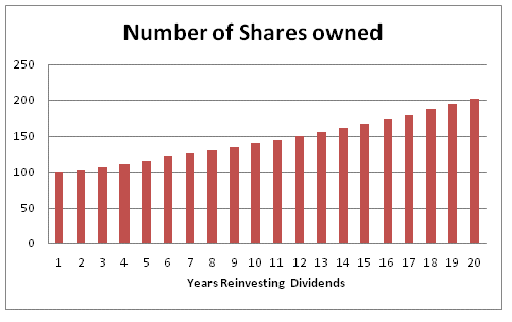While a significant portion of my personal stock holdings are small caps, I've always made sure to own a healthy number of dividend-paying stocks too (including small, mid and large caps).
The carrot here is that using very conservative assumptions and buying household names, it's possible to double your money over 20 years – even if your stock trades totally flat.
I've recently realized that not many people understand how this is possible. In fact, some of my closest friends didn't know how to reinvest their dividends to begin with … before we got to talking about it.
This needs to change.
I realize that a lot of people buy dividend-paying stocks to generate necessary income. But it's worth stating that one of the guiding principles of investing is to forgo spending money now in order to have more later on.
So if you don't need the income, are younger and/or plan to hold your stock for a long time (or give it to your kids or grandkids), I strongly recommend enrolling all of your dividend-paying shares in a Dividend Reinvestment, or DRIP, program.
Doing so can make the difference between a little money now and a lot of money later.
Better still, it's essentially painless to do. Just contact your broker and instruct them to enroll your eligible shares in a DRIP. That should take care of it – you just sit back and accumulate shares as time goes on.
Reinvesting your dividends means you can potentially double your money, even in a flat market. To understand how this is possible, it’s best to use a simplified example with a few key assumptions:
Let's say you buy 100 shares of a stock that yields 3.75% annually and enroll it in a DRIP.
Great companies yielding close to this today include Chevron (NYSE:CVX) and BHP Billiton (NYSE:BHP).
Now assume the stock trades flat for the next year. After owning the DRIP-enrolled stock for one year your ownership increases by 3.75%, to 103.75 shares.
After a second year of trading flat, your 103.75 shares become 107.64 shares. After five years of trading flat you own 115.87 shares and after 10 years you own 139.28 shares. At this point you could sell for a 39.28% gain. Remember this assumes zero capital gains over the 10 years.
After 20 years, assuming the stock price hasn't moved at all (and you've done absolutely nothing), you'll own 201.27 shares – twice as many as you originally bought.
Despite the share price trading flat the compounding effect of reinvested dividends means the value of your initial investment has gone up by 101%. This is how it looks in a graph.

While this is clearly an oversimplification, it's so easy to comprehend for a base-case scenario that I find it gets people's attention, mainly because a 3.75% yield is pretty attainable.
From here you can tweak the numbers to suit your risk profile. If you want to try to double your money in just 10 years, your magic yield is 8%. You can come close to that with some utilities or master limited partnerships (MLPs).
Or if you are really aggressive and a bit more risk tolerant, a 12% yield means you'll double your money in just over seven years, again assuming your stock trades flat.
The implications here are pretty straightforward. You're not necessarily looking for a big rise in the share price but rather an increase in your ownership of the company.
Of course, these days it's more likely that the share price will rise over time, resulting in a much larger total return. That higher share price could mean your reinvested dividends will purchase fewer shares, but solid dividend payers have a cure.
The ones you will want to buy should have established track records of maintaining a target dividend yield. This means they increase the amount of the dividend over time to keep pace with share price appreciation.
Like I said, enrolling shares in a DRIP is painless; just contact your broker and it's free. After you do so, all future dividend payments will be reinvested in new shares of stock (even fractional shares), without commissions. I've done so with all of my dividend-paying stocks, and I don't expect to remove them anytime soon.
 Facebook
Facebook
 Twitter
Twitter